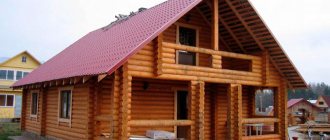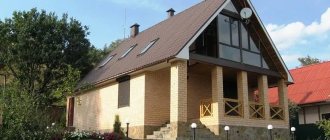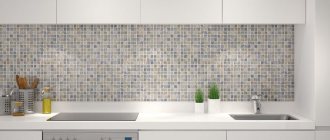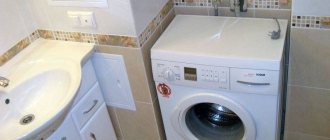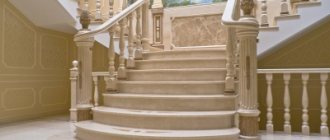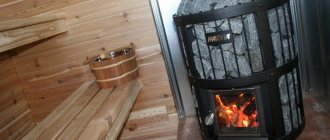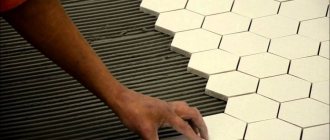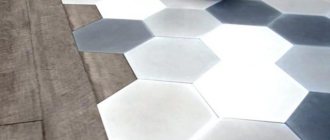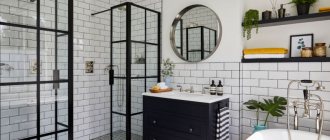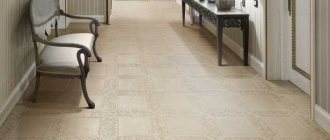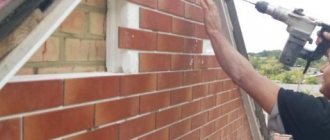Facade tiles are one of the beautiful, durable and durable types of exterior design and finishing of buildings. It will update the appearance of the building and provide high-quality heat and sound insulation. At the same time, such material does not imply difficult installation, does not require constant updating and complex maintenance. A wide variety of types and methods of fastening allows any home owner to choose the appropriate option that meets his preferences and tastes.
In this article we will tell you how to finish the facade of a private house with tiles. We list the existing varieties, indicate their characteristics and present the stages of work that are performed during installation.
- 1 Features of the material
- 2 Types of facade tiles
- 3 Advantages and disadvantages of such finishing 3.1 Advantages of facade tiles
- 3.2 Disadvantages of the material
Features of the material
It refers to exterior cladding options made from various types of stone and clay. It stands out for its unpretentiousness and durability, relative ease of installation. In the vast majority of cases, it retains its natural shade and texture; less often, some kind of coating can be imitated using such finishing. Often has a production system similar to the process of making bricks or building blocks.
Unlike other cladding options, each piece of tile is installed separately, which makes it easy to replace them if necessary. They do not adhere to each other and can be easily removed using simple tools, which distinguishes the material from siding or special panels.
Benefits of this approach
- Facade tiles do not require reinforcement of the foundation, unlike the same facing brick;
- The variety of shapes, colors and textures allows you to use tiles in almost any design;
- The tiles withstand all natural and physical influences and do not react to acids, alkalis and other aggressive chemical compounds;
- Some types of facade tiles practically do not absorb water, which not only protects the walls from moisture, but also allows the cladding to survive freezing and thawing cycles without damage;
- The material is unpretentious and can be effectively cleaned with improvised means (with some exceptions).
The only drawback of the tile material is its price. And even though prices within the category itself can be very different, in general this façade finishing option cannot exactly be called budget. As a compromise, you can cover not the entire wall with tiles, but only its fragments, thus creating interesting visual solutions.
Types of facade tiles
- Stone - marble, basalt, granite and other rocks are used for cladding buildings. They are distinguished by a natural shade, a wide variety of textures, but are more expensive than other models.
- Clinker - made using the same technology as the brick of the same name. Only the tiles are much thinner, which simplifies its installation. Made from high quality clay. It stands out for its strength, durability and resistance to damage.
- Porcelain tile - otherwise called “artificial stone”. It is used for the construction of ventilated facades based on a durable frame. Less often, such canvases are mounted with special glue.
- Concrete - can imitate a coating with any pattern and texture. Installed in various ways, depending only on the size of the fragment.
- Terracotta - used to recreate the finish in the spirit of an old house. It is created from clay by firing at high temperatures, which is why it has a pleasant, beautiful shade. But such tiles require complex and constant maintenance, although all costs are recouped due to their attractive appearance.
- Agglomerate - made from crumbs of ground natural stone. When processed, it forms thin and durable layers that are no different in color from natural materials.
TechnoNIKOL HAUBERK facade tiles and its types
TechnoNIKOL facade tiles are made on the basis of fiberglass, improved bitumen and basalt topping.
Main advantages:
- does not fade in the sun due to basalt granules in the top layer
- Easy installation so you can do it yourself
- tightness
- resistance to temperature changes
- can be used for complex projects
- warranty - 20 years
TechnoNIKOL facade tiles are available in the following options:
- baked brick
- sand brick
- terracotta brick
- beige brick
- marble brick
- antique brick
- Red brick
Tools required for laying tiles:
- hammer
- knife
- metal scissors
- level
- lace
- screwdriver
- nails and screws for metal, galvanized
- construction hair dryer
Advantages and disadvantages of this finish
Advantages of facade tiles
- Suitable for decorating buildings made of wood, brick, and foam concrete.
- Available in a large number of shades and designs.
- It is easily and simply dismantled, which allows it to be reused.
- It resists mechanical and atmospheric influences well.
- Most models do not require maintenance or complex maintenance.
- Resistant to frost - does not crack, does not fade or lose its other qualities.
- Features a long service life. Using the example of many houses, it is clear that such a coating can last for decades without complex repairs.
Disadvantages of the material
- Large mass, which can negatively affect old or weak foundations and supporting structures.
- It does not allow moisture to pass in both directions, so a ventilation system is initially thought through.
- The high cost of all models can scare off many. To cover the entire building with such a coating will require quite a lot of money. Or you need to do all the work yourself, which is not as difficult as it seems.
Characteristics of facade tiles
Whatever material the facade tiles are made from, they have general quality indicators. It is thanks to them that a unique, completely new external facade of houses is created and external facades become attractive.
An example of finishing a façade with decorative tiles
. Features:
- has a high level of strength;
- is a lightweight material;
- increased level of hardness;
- not subject to fire;
- has a very low level of water absorption. Since water cannot penetrate inside this material, and when it flows, it washes away dust and other contaminants from its surface without disturbing the structure, the service life increases;
- is an environmentally friendly material;
- easy to clean;
- not subject to aggressive influences from external irritants;
- frost resistance;
- has a wide range of colors and different geometric shapes.
Using this finishing material, the external facade of the house can be decorated in almost any style. It will not be difficult to implement any design solutions.
Photo of finishing a house with facade tiles
How to attach facade tiles to the wall?
There are two main methods:
- Wet - on the adhesive composition. Only moisture-resistant varieties are purchased. Each of them is selected individually for the type of material. In order not to make a mistake, it is advisable to check with sellers in stores for what kind of work this or that type is suitable.
- Dry - to the sheathing with screws or clamps. This is how large fragments of cladding are usually fixed; less often they can be found when installing small varieties.
The most popular material
The finishing touch in building a house is the finishing. It allows you not only to make the building beautiful, focusing the attention of others on it, but also increases its service life. Various materials are used for this, but one of the most popular is considered to be façade tiles with metal fasteners Canyon. Facing a building using ceramics protects it from exposure to sunlight and precipitation, thereby preventing it from destruction.
Watch a video about the use of tiles:
The good performance properties of the material are explained by its composition and production method. Typically, two main components are used to make ceramic tiles:
- Cement;
- Sand.
Despite the composition being common to different types of material, it differs not only in appearance, but also in technical characteristics. For example, on sale you can find both standard tiles with metal fasteners for facades imitating brick or stone, and with increased thickness and increased frost resistance.
Therefore, when choosing a specific model, a variety of factors are taken into account:
- Weather;
- The material from which the house is built;
- Surrounding area.
But besides this, you need to find out in advance how to attach facade tiles of one type or another. This determines how competently the work will be done and how long the cladding will last.
Features and stages of installing tiles with glue
In this way, houses made of brick or foam blocks are most often finished. This is often combined with insulating the walls from the outside with polystyrene foam or expanded polystyrene. First, the insulation is laid, then the sheathing is erected, which is plastered, and only then proceed to the work itself.
Finishing the facade of a house with tiles takes place in several stages:
- The surface is primed.
- The adhesive composition for one or another type of material is mixed. This should be done in strict accordance with the instructions.
- The adhesive is applied to the wall in one direction with a notched trowel, and to the tile segment in the opposite direction, which ensures better adhesion.
- Installation of facing tiles begins from the bottom corner and is carried out gradually upward to the entire canvas. For alignment, markings are made before starting installation. You can nail a guide to the very bottom, which will then be removed.
- Each fragment is pressed tightly against the wall and tapped with a spatula.
- After drying, the seams are grouted with moisture-resistant grout. It is important to remember that you must remove the excess immediately, otherwise it will dry out and not be cleaned.
Types of facade tiles
Facade tiles are a modern finishing material used for various types of exterior finishing work, in particular finishing building facades and paving paths. It is ideal for both new buildings and the renovation of old ones, giving them a completely new look . At the same time, its service life is an order of magnitude higher than, for example, that of facade plaster, and its protective and decorative functions are an order of magnitude higher. Facade tiles have several varieties:
- terracotta tiles (has the natural color of fired façade tiles made from red clay);
- façade tiles with a thin layer of glass coating;
- façade tiles covered with a thin layer of ceramics (anglobing);
- two-layer facade tiles with a decorative ceramic coating formed as a result of baking.
There are also tiles made of sandstone, shell rock, concrete and other materials.
Brick-like ceramic facade tiles
Terracotta facade tiles
Terracotta facade tiles This type of tile has been used for quite a long time. With its help, external finishing of the facade of the house, external finishing of the facade of the house and other finishing works are carried out. The material is characterized by a characteristic surface roughness associated with the heterogeneous structure of the raw material (clay). Thanks to the use of different types of clay, the shades of the tiles differ from each other. No artificial colors are added. Material Features:
- does not collapse due to exposure to high temperatures;
- retains its original color and appearance when exposed to direct sunlight and precipitation, withstands low temperatures well;
- does not burn when exposed to fire.
Thanks to these characteristics, tiles can be used for finishing floors, paths and other objects. The price of the material is quite affordable and practically does not differ from other types of facade tiles.
Technology for installing facade tiles on fasteners
The method assumes that the fragments are attached to the base in the form of a lathing - wooden or metal. The first one is more preferable. All actions take place in several steps:
- Careful markings are carried out using a level, and guides are set.
- A grid is created with a step width not exceeding the dimensions of the tile.
- A layer of sealant is laid so that there is a bridge of cold in it. A vapor barrier membrane is placed on top. There remains a small gap between the tile and the thermal insulation layer for ventilation and condensation drainage.
- Installation of facing tiles begins from the bottom corner of the building and gradually goes up. Fastening is done using the hardware that comes with this type of finish.
Installation instructions for HAUBERK façade tiles.
Preparing the base for facade tiles.
First of all, prepare a durable, dry and moisture-resistant wooden facade flooring. The thickness must be at least 9mm. It could be:
- OSB-3 board.
- FSF plywood.
- Grooved edged board.
The relative humidity of the base should be no more than 20%.
To fasten the base you will need:
- Galvanized universal self-tapping screws 5x45mm
- Screwdriver
- Roulette
- Pencil
Base fasteners
OSB-3 boards must be fastened like this. From the side at the level of the angle, taking into account the overhang to the width of the guides. Below the level of the plinth. Installation is carried out with the displacement of the slabs at intervals to ensure rigidity at the joints. The plates are fastened using self-tapping screws. Step 30-40cm.
To avoid thermal expansion between the plates, it is necessary to leave 3 mm gaps.
In the window area, the slabs are installed in such a way that the joint of the slabs does not fall on the corner of the window. To do this, an L-shaped cut of the slabs is carried out.
Marking the base
Before laying the façade tiles, the base is marked. This will help align the tiles horizontally and vertically. The pitch of the vertical marking line is equal to the width of the tile 1000mm. The pitch of the horizontal lines is approximately 5 rows of tiles, or 650 mm.
How to properly arrange the corners?
Openings, windows and all turns of the building are designed first, since otherwise it will be extremely difficult to fit them later. Some models are complemented by special corner profiles.
To get beautiful charcoal, the facing material is cut and lined up along the wall precisely level. When all the protrusions are formed, you can proceed to filling the wall canvas.
Features of grouting joints
After finishing the building with facade tiles, they seal the joints and free areas between the panels. To do this, use moisture-resistant grout or the remains of tile adhesive, if it matches the tone. They work quickly; excess layers are removed immediately, since they dry extremely quickly and are almost impossible to clean off.
Thus, you can install facade tiles with your own hands if you follow a few simple rules and instructions for the materials. To begin with, select the material and suitable fasteners - glue or hardware. Then the walls of the building are processed and prepared, after which you can safely begin cladding. Such a coating will last for many years and does not require complex maintenance, which explains its popularity.

